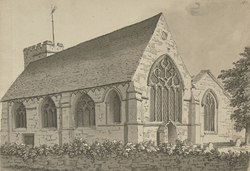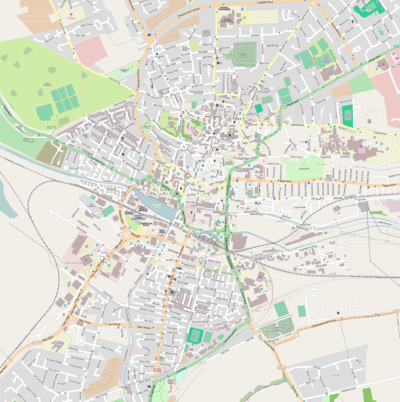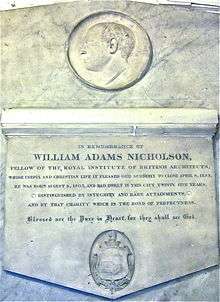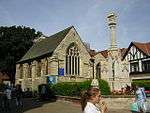St Benedict's Church, Lincoln
St. Benedict's Church, Lincoln is an ancient church in Lincoln which is mentioned in 1107 and before the English Civil War was the Lincoln Civic Church. It was extensively destroyed in the Civil War, and was only partially restored. The tower was re-built imitating the other late Saxon towers in Lincoln. All that survives is the present nave, which was the chancel of the former church' and the chapel to the north built by Robert Tattershall in 1378. The church's bell known as Old Kate, was cast in 1585 and paid for by the Lincoln Barber's Surgeons Company. The church was closed in 1931 and demolition was proposed. However, following a public outcry, the church was saved as the result of an appeal and renovation work undertaken. It is now the headquarters of the Lincoln Diocese Mothers' Union. It is open to the public on Tuesdays, Thursdays, Fridays and Saturdays from 10:00 am to 2:30 pm,[1]
| St. Benedict's Church, Lincoln | |
|---|---|
 St Benedict’s Church, by Samuel Hieronymus Grimm,1784. | |
 St. Benedict's Church, Lincoln Shown within Lincoln | |
| Location | Lincoln, Lincolnshire |
| Country | England |
| Denomination | Church of England |
| Architecture | |
| Functional status | Now the headquarters of the Diocese of Lincoln Mother’s Union. |
| Heritage designation | Grade II* |
| Designated | 8 October 1953 |
| Style | Medieval |
| Closed | 1931 |
| Administration | |
| Diocese | Lincoln |
The Parish of St Benedict.
The parish was one of the smaller parishes in Lincoln. In the general re-organisation of the Lincoln parishes which took place in 1553, part of the parish of St John's was amalgamated with St Benedict's parish.[2]

On Padley's large scale map of 1842, the parish is shown as extending from the Brayford Pool on the west to Sincil Street on the east. It included the length of the High Street from just north of the River Witham and the High Bridge to the Cornhill to the south[3]
Furnishings in the Church
These include a late 17th-century octagonal panelled oak pulpit and an 18th-century eggcup font with swags and square stem. A Royal Coat of Arms of 1734, was repainted in 1819, with the churchwardens' names. A brass with weepers, 1687, scrolled cartouche with arms and cherubs, 1739, and a memorial to the noted Lincoln architect William Adams Nicholson of 1853.[4]
St Benedict. Gallery
|
See also: Churches in Lincoln
References
- Lincoln Diocesan Mothers' Union
- Hill, (Sir) J.W. F, (1956), Tudor and Stuart Lincoln, Cambridge University Press, 57-58
- Mills D.R. and Wheeler R.C. (2004), Historic Town Plans of Lincoln, 1610-1920. 1842/8
- British Listed Buildings
Literature
- Antram N (revised), Pevsner N & Harris J, (1989), The Buildings of England: Lincolnshire, Yale University Press. pg 496



